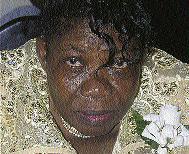
Winston Sill/Freelance Photographer Nadine Willis
She started out as a go-go dancer at Gemini nightclub but today Nadine Willis is a supermodel for Pulse Investment Ltd.
Moving from an inner-city background to the catwalks of the world's fashion capitals, she has become the most successful Jamaican model and the first black girl to do a Gucci campaign. Willis had a lifetime of struggles before getting her big break. She lived with a father who was constantly drunk and who physically abused her. At an early age she had to take on managing the household, cooking, cleaning and washing.
At age 14 she began working as a housemaid making beds at a hotel. Her employer told her she could do better than make beds and introduced her to dancing. She was taught to dance and learnt fast because she was ambitious. Seven years later she moved to Gemini nightclub.
Drastic change
However, in 2003 her life changed drastically when she became a top Pulse model. She was featured on magazine covers such as London's Pride in the August 2005 issue. In its special Caribbean issue, the magazine hails Willis as Jamaica's "hottest" export. The issue takes a look at her unprecedented rise from poverty to Gucci and Vogue supermodel and her current successful international career.
Ms. Willis also appeared in London's Sunday Times magazine (twice) and Aspire in 2005. Earlier that year British Vogue revisited her story and updated her success as an international model. She has appeared in almost every important fashion magazine and six different Vogue publications - British, French, Italian, Japanese, German and Spanish.
Also, last Independence Day, August 6, 2006 she became the first Jamaican modelto be honoured by SuperClubs when Suite #639 at the Hedonism III property was officially dedicated and renamed in her honour.

Ian Allen/Staff Photographer
Tanya Stephens
A woman with a golden pen, Tanya Stephens, born Vivienne Stephenson, is easily one of the best female songwriters and singer to have graced Jamaica's music scene in the last decade.
From her debut album Gangsta Blues in 2004 to the recently released Rebelution, this mystic singer has deftly inserted social commentary in all her songs and forced her way into the forefront of Jamaica's music. Her well-thought-out and penned lyrics speak to serious life issues while adding comedy to the mix. Tanya's unique voice has brought to dancehall a certain class and ingenuity that existed among only a few local female artistes.
Gangsta Blues, released in 2004, confirmed her status as Jamaica's top female music act. Her single It's A Pity, on the 'Doctors Darling' riddim, was one of the biggest tunes of 2004, and earned her international recognition from media outlets such as MTV Jams, The New York Times, Village Voice, Source, and Vibe Magazine. The album is still featured on the Billboard Reggae Chart.
In 2006 Tanya released her second album Rebelution, which was well anticipated. The album received recognition from the British Broadcasting Corporation that featured the witty artist in a documentary based on Jamaica. The album was also featured in a London-based magazine as one of the best releases of 2006.

Shirley Allison Blake
In the '60s and '70s when most Jamaicans were migrating to greener pastures, Shirley Blake decided to stay and care for her children despite the hardships.
After the 1980 election, her home was robbed and the stock in the small family shop was completely wiped out. She and her husband weretied up, gun-butted and shot. The family had no choice, but to leave their home.
She then decided to get her family a house of their own. Though they didn't have the money, she knew it could be done. Today, the house stands as a testament to her determination to succeed and make the best for her family. In order to satisfy the mortgage payments and provide for her five children, she sewed (she is a dressmaker), and then walked to offices in and around Kingston selling her goods, and material that she purchased wholesale.
Though she has had some major medical problems and was hospitalised many times, her children are still the centre of her world and she constantly tries to find ways in which she can help them whenever they encounter challenges. Through her own efforts and that of her husband, she was able to give all her five children a good education, and a good life, and today all her children are proud owners of their own home and doing well in their various jobs - a principle she constantly instilled in them.

